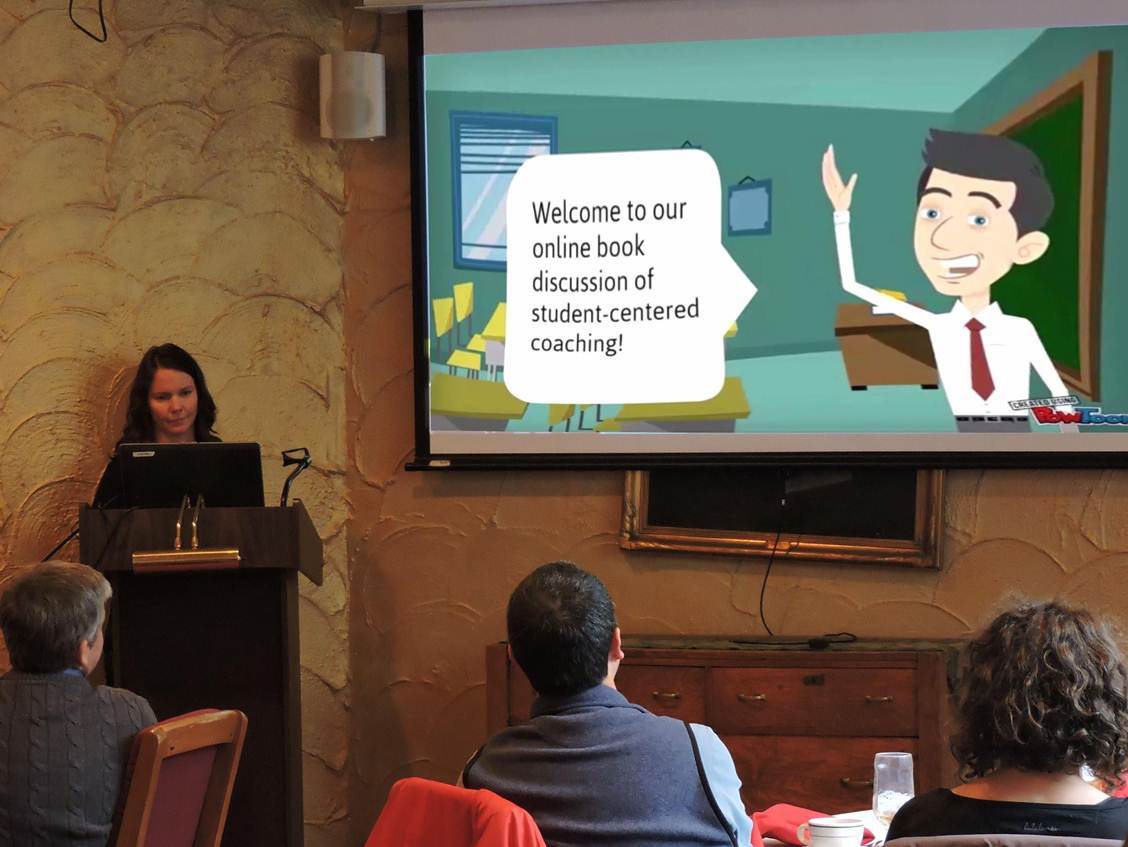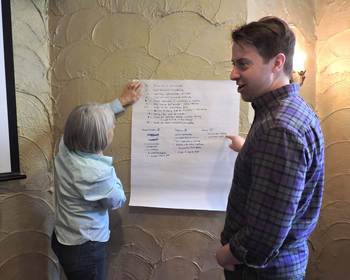Community of practice helps faculty and staff step into role of online learner

Lisa Hebgen and other TeachOnline@UW participants shared their lessons learned during mini-presentations after the Fall 2014 workshop.
This past year, more than 20 faculty and instructional staff received another chance at being a student — a role reversal that allowed each of them to explore the opportunities and challenges facing today’s online learners and instructors.
As participants in UW–Madison’s inaugural TeachOnline@UW learning community, participants from eight schools and colleges came together to learn and share strategies for designing and teaching quality online courses. Over 12 months, they met and completed online coursework to learn how to better design and manage courses with specific learning goals, and to explore the use of new tools to help their teaching and their students.
Participants ranged from senior faculty who were already familiar with online teaching to newer instructors just getting started at the UW. They kept journal entries about their experiences, mapped their courses, and participated in interactive exercises that put them in the role of online students. Throughout these experiences, participants developed tools and strategies to create more engaging and active online learning experiences for their students, though participants have said what they learned will also improve their face-to-face courses. “Participants learned the most about course design and teaching by experiencing being an online student,” says Karen Skibba, TeachOnline@UW project lead.
Many interactive activities were showcased in the TeachOnine@UW online courses, including this game that tested participant knowledge of online assessments.
“I believe that TeachOnline@UW has led me to be even more thoughtful in my approach to designing a class. I have really embraced the idea of backward design, which means starting with the big picture of what I want students to learn and then working from there,” says Parvathy Pillai, assistant professor in the School of Medicine and Public Health. Pillai says she is excited to share all the tools she learned about in the workshop, including the course map and Quality Matters Rubric, which are standards used to evaluate the design of online and blended courses.
After completing the program, some instructors now call themselves “converts” to online teaching. For Lalita du Perron of the Center for South Asia, the program helped her understand how to integrate the right mix of technology into her Languages and Cultures of Asia 252 course. She was able to incorporate the new tools in a way that complements and supports the learning goals she has for her students.
Du Perron admits that all of the technology was a bit overwhelming at the beginning. But, by choosing a few places to start, she got comfortable and realized that she can do more with technology next year, continue to grow, get student feedback and improve.
“My course is 40 years old and was previously taught by Professor Joe Elder. This was the first year it has been taught online, which is exciting,” she says. “For me, a big selling point of online learning is that it promotes diversity of learners, as well as flexibility for both teachers and students. For people who have other commitments, full-time jobs, or children, online learning gives them options and they can now take my class.”

Tracy Schroepfer and Alan Rubel prepare for a debate about different communication models in online courses.
All of the program’s participants are actively applying what they have learned to current and future courses they will teach. For Sue Wenker of the Department of Orthopedics and Rehabilitation, this means using some new tools, such as discussion threads, podcasts, online video, online polls and surveys to enhance interprofessional learning opportunities and practical experiences for future health care providers.
“Now I am more cognizant of which tool may best meet my students’ needs, how I am going to manage the student learning and communication if I implement this tool, and to what degree technological barriers exist for my students. I am definitely more aware of the challenges students face,” added Wenker.
As more students on and off campus look to online learning and other flexible options, helping faculty and staff to provide high quality and engaging online opportunities is more important than ever.
In 2013-14 alone, there were more than 11,000 distance education enrollments by UW students. In addition, since the beginning of the Educational Innovation initiative in 2011, UW–Madison has launched 10 new online degree programs that are serving new audiences, with additional programs in development.
If you are interested in learning more about the second cohort of TeachOnline@UW or other professional development opportunities for online teaching and learning, please contact Karen Skibba, kskibba@dcs.wisc.edu, or attend a special post Teaching and Learning Symposium event on May 21 where the learning community participants will share their lessons learned. More details of the program and how to apply for Fall 2015 will also be provided.
The TeachOnline@UW learning community was facilitated by a cross-campus committee and funded by Educational Innovation (EI), an initiative supported by the chancellor and the provost that aims to engage and inspire students through enriched learning.

